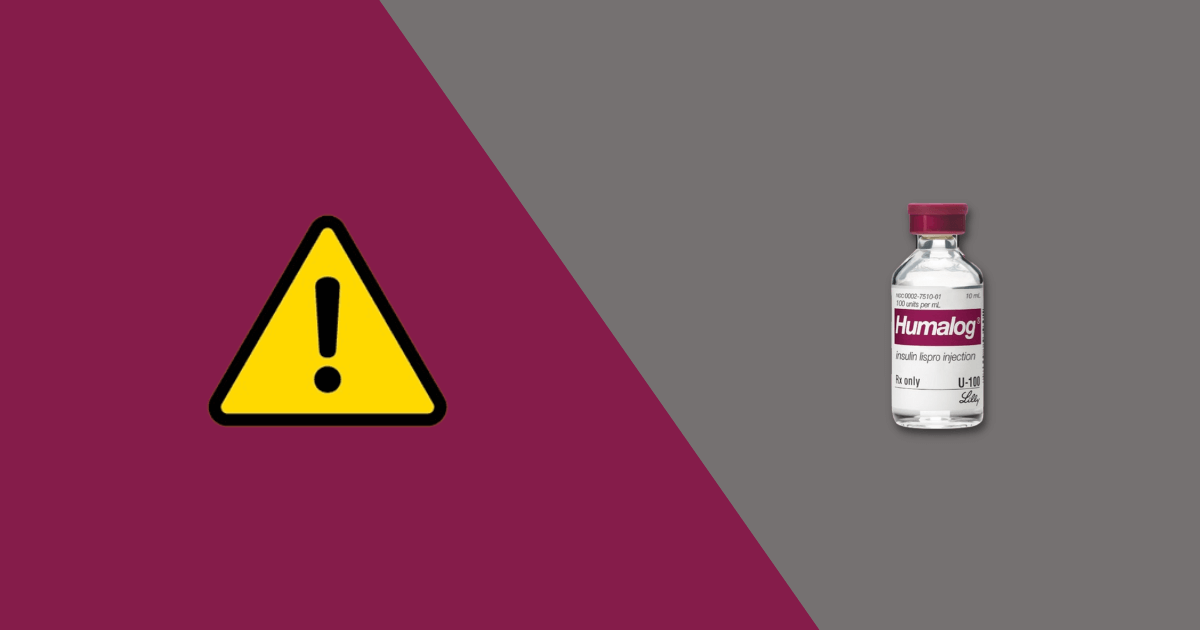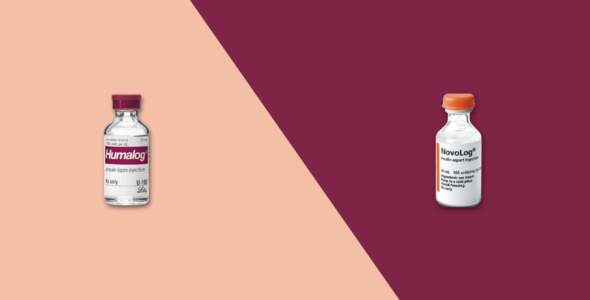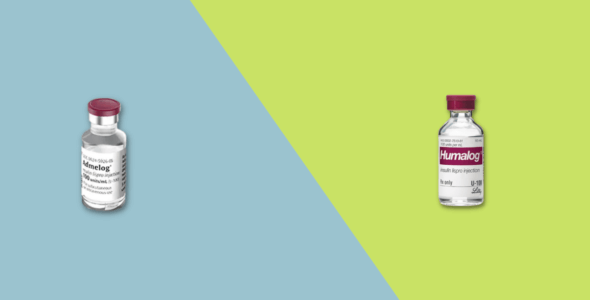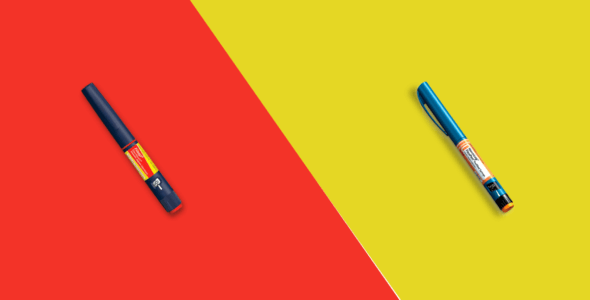Humalog side effects and how to avoid them
Table of contents
Humalog is an FDA-approved brand-name diabetes medication manufactured by Eli Lilly. It is classified as a type of insulin used to treat diabetes. While Humalog is generally well tolerated, there are some potential side effects that people should be aware of. The most common side effects of Humalog include injection site reactions. Less common, but more serious side effects, can include hypoglycemia.
Learn more about the side effects of Humalog and what you can do to avoid them.
What is Humalog (insulin lispro)?
Humalog is a fast-acting insulin used to treat type 1 diabetes and type 2 diabetes mellitus. You inject Humalog under your skin or use it with an insulin pump just after you’ve eaten, to lower your blood sugar.
The active ingredient in Humalog is called insulin lispro, a rapid-acting insulin. It’s similar to normal human insulin, and works in the same way, but has been modified to be faster acting. When you inject or pump Humalog into your body, it enters your blood supply. It then increases the rate at which your liver, and your fat and muscle cells, absorb sugar from your blood.
Check with your doctor or pharmacist before taking any medication, including Humalog, to make sure it is safe for you.
What are the common side effects of Humalog?
The most common possible side effects of Humalog include:
- Injection site reactions
- Lipodystrophy
- Weight gain
- Edema
- Pruritus
- Rash
Humalog can cause more serious side effects, including:
- Hypoglycemia (low blood sugar) – increase how often blood glucose is monitored when there are changes to insulin dosage, other glucose-lowering drugs, changes in meal pattern, or physical activity in those with renal or hepatic impairment, and in patients with hypoglycemia unawareness. According to the American Diabetes Association symptoms of low blood sugar levels include anxiety, behavior similar to being drunk, blurred vision, cold sweats, confusion, depression, lightheadedness, drowsiness, hunger, fast heartbeat, headache, irritability, restless sleep, and tingling in the hands, feet, lips, or tongue
- Severe life-threatening allergic reactions – swelling of the face or throat, shortness of breath, trouble breathing, or itchy skin rash
- Hypokalemia (low potassium levels)
- Fluid retention and heart failure when used with thiazolidinediones
If you experience any of these serious side effects, stop taking Humalog and seek medical attention immediately. You are encouraged to report negative side effects of prescription drugs to the FDA. Visit www.fda.gov/medwatch, or call 1-800-FDA-1088.
What are the long-term side effects of Humalog?
Long-term use of Humalog may cause lipodystrophy at the injection site with repeated use. Lipodystrophy includes the thickening or thinning of adipose tissue and can affect the absorption of insulin.
Humalog dosage
Humalog is available as 10 mL vials, 3 mL prefilled pens, 3 mL Humalog KwikPen prefilled Pens, or 3 mL cartridges.
Humalog may be administered as a subcutaneous injection in your thighs, buttocks, or upper arms, as a continuous subcutaneous infusion, or intravenously. Your dose will be based on your condition and the method of administration.
You may experience hypoglycemia when using Humalog and feel hungry, irritable, dizzy, confused, or shaky. To treat hypoglycemia quickly, eat or drink a source of sugar such as fruit juice, glucose tablets, raisins, or soda. Your healthcare provider may prescribe a glucagon kit just in case you develop severe hypoglycemia. Be aware that increased thirst or urination are signs of high blood sugar.
Store Humalog away from heat and light. Do not freeze and throw away insulin that has been frozen. Refrigerate Humalog and use until the expiration date or keep at room temperature and use it within 28 days.
You are advised to read the medication guide provided with this medicine for the drug information and patient information, and always speak with your healthcare provider for medical advice about any changes to your dose so they can monitor and evaluate your condition.
Humalog drug interactions
Humalog can interact with other medications including:
- Antidiabetic agents
- ACE inhibitors
- Angiotensin II receptor-blocking agents
- Monoamine oxidase inhibitors
- Atypical antipsychotics
- Corticosteroids
- Estrogens
- Beta-blockers
- If you have heart failure, taking thiazolidinediones such as rosiglitazone and pioglitazone may make heart failure worse
Before taking Humalog, be sure to tell your doctor about all of the medications you are taking to ensure they are safe to take at the same time.
Does Humalog cause hair loss?
Hair loss is a side effect of using Humalog, especially in 60+ females, who have been taking Humalog for 2 to 5 years.
Does Humalog cause heart problems?
Humalog can cause heart-related problems such as changes in your heart rhythm. Your heart may feel as though it is racing, fluttering, or skipping beats.
Humalog warnings & precautions
Don’t take Humalog if you:
- Are allergic to the active ingredient insulin lispro
- Are allergic to any of the other ingredients found in Humalog (listed in the leaflet which comes with the medication)
- Think hypoglycemia is starting (a fall in blood sugar to low levels)
Talk to your doctor before using Humalog if you:
- Often have hypoglycemia or have problems recognizing it’s happening
- Have problems with your kidneys or liver
- Have recently become ill
- Are exercising more than usual
- Are planning to travel or go on vacation (time differences can change when you eat and when you take your Humalog)
- Have heart failure or other heart problems
- Are breastfeeding or plan to breastfeed
You should always check with your doctor or pharmacist before taking any medication, including Humalog, to make sure it is safe for you.
How long does Humalog stay in your system?
Humalog begins to work within 15 minutes, reaches a peak around 1 to 2 hours after injection, and works for about 2 to 4 hours.
Is diarrhea a side effect of Humalog?
Yes. Humalog may cause diarrhea in some patients. Speak to your doctor if you often have diarrhea when using Humalog.
What are the side effects of not having enough insulin?
Not having enough insulin will cause your body to break down its stores of fat and muscle, leading to weight loss and diabetic ketoacidosis, a condition where the bloodstream becomes acidic, ketones build up and you become dehydrated.
What other insulin is there?
Other types of insulin include short-acting insulin, intermediate-acting insulin, mixed insulin, and long-acting insulin. Which insulin works best for you will depend on you as an individual and will be dependent on factors such as your age, weight, and your symptoms of diabetes. Speak to your doctor for further advice.
How to avoid Humalog side effects
The best way to avoid side effects is to take Humalog as directed by your doctor. Follow your doctor’s instructions carefully and do not take more or less than prescribed.
If you experience any side effects, talk to your doctor or pharmacist. They may be able to recommend ways to help reduce or prevent some of the side effects.
1. Stick to the recommended dosage
Take your prescribed dose of Humalog that has been recommended by your healthcare professional. Do not take more or less than prescribed.
2. Monitor your blood sugar levels
If you have diabetes, it is important to monitor your blood sugar levels closely while taking Humalog. Check your blood sugar levels as directed by your doctor and report any changes to your doctor immediately.
3. Drink plenty of fluids
Drink eight to 10 glasses of water or fluids every day to help prevent dehydration, which can make side effects worse.
4. Avoid alcohol
Avoid drinking alcohol while taking Humalog as it can increase your risk of hypoglycemia.
5. Don’t skip meals
Eating regular meals and snacks will help to prevent low blood sugar levels (hypoglycemia).
6. Check your feet
If you have diabetes, check your feet for any cuts, sores, or redness regularly. Tell your doctor if you experience any problems with your feet while taking Humalog.
7. Know the signs and symptoms of Humalog side effects
Signs and symptoms of side effects include feeling tired, and shortness of breath. If you experience any of these symptoms speak to your healthcare provider for medical advice.
8. Monitor your weight
Humalog may cause weight gain. If you experience this side effect while taking Humalog, get medical advice from your doctor.
9. Tell your doctor about all medications you’re taking
Be sure to tell your doctor about all other medications you’re taking, including over-the-counter drugs, vitamins, and herbal supplements, as they can interact with Humalog.
10. Get regular medical check ups
It is important to get regular medical check ups and monitor your medical conditions. Your doctor will monitor your side effects and may adjust your dose of Humalog as needed.
Medically reviewed
A medical professional has reviewed this article.


Jamie Winn, PharmD
Jamie Winn, PharmD
Dr. Jamie Winn received his Doctor of Pharmacy in 2002 from the University of South Carolina College of Pharmacy, Columbia, SC. Jamie is a medical reviewer for NiceRx.




